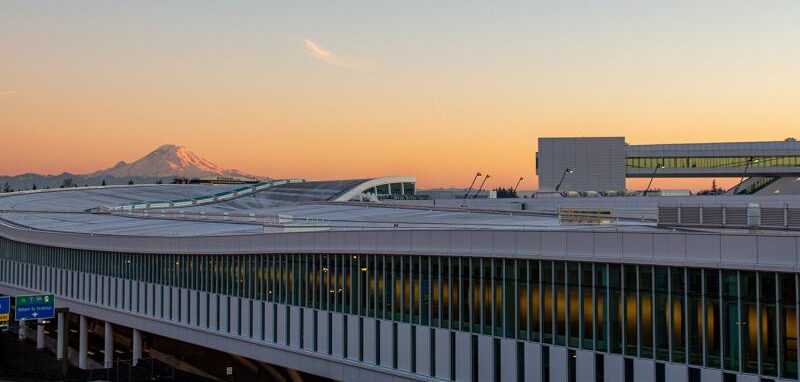Seattle-Tacoma International Airport (Sea-Tac) in Washington has begun preparation for final readiness testing of its International Arrivals Facility (IAF).
The three sections of the IAF are the passenger walkway, the extension on A Concourse and the 450,000ft2 Grand Hall. This walkway will feature views of Mt Rainier, the Olympic Mountains and the Seattle city skyline. The renovation has created eight more international gates, a faster passport check clearance and increased the airport’s passenger capacity to 2,600 passengers per hour. It has also reduced the minimum passenger connection time from 90 to 75 minutes. Alongside this, the airport now has two more bag claim carousels and has also installed nursing rooms, pet relief areas and restrooms.
The architecture and artwork of the IAF has been curated to mirror the region through colors, shapes and movement. Materials used in the facility feature the blues of the sea and sky and the greens and organic textures of the mountains and forests. Approximately 100,000ft2 of the terrazzo floor was sourced from local stone to form a rock pattern that evokes the colors and textures of a rocky Pacific Ocean beach. Wood accents are intended to bring warmth and nature into the space.
Chalchiutlicue, a five-piece sculpture by artist Marela Zacarías over the bag claim carousels, was inspired by the colors of the waterways and sunsets in the San Juan Islands. Magnetic Anomaly, three kinetic artworks created by Ned Kahn, consists of spinning suspended metallic mobiles that are inspired by the wind and changeable Pacific Northwest weather. Indigenous art is also planned to arrive soon to the IAF with works by six Native American artists, including renowned glass artist Preston Singletary and the interdisciplinary artist Marie Watt.
To be sustainable, this facility has incorporated low-flow restroom fixtures to reduce indoor water use. Energy-saving features like LED lighting, energy-efficient escalator motors and variable speed motors on baggage handling devices have also been included. Similarly, two-thirds of the building uses daylight to reduce energy consumption. The construction team has also ensured the diversion of 7,163 tons of contaminated soil from landfills and the removal of 62,405 gallons of impacted stormwater from the project site. Furthermore, materials were sourced within 100 miles as much as possible. This included low-emitting adhesives, materials and coatings.
Before the airport can begin operations, it must undergo the operational readiness, activation and transition (ORAT) process. Sea-Tac’s ORAT team leads this activation period in collaboration with federal agencies and airline partners. More than 1,000 airport employees, tenants and frontline staff have taken familiarization and training tours covering integrated systems, including airline and ground handler operations, passenger processing, carousels and baggage handling systems, security and emergency response drills as well as building readiness for heating, ventilation and air conditioning (HVAC), waste management, restrooms and other amenities.
To prepare for the opening, the airport has scheduled a passenger flow simulation with hundreds of volunteers to evaluate the functionality and flow of passenger journey elements such as elevators and escalators, wayfinding and signage, baggage claim, inspection and re-check. This feedback will be considered in the final operation plans.
The final phase of operational readiness will begin when the IAF serves a limited number of early morning flights on the A Concourse over a multi-day period. This final operational readiness testing ensures that the facility and staff are prepared to serve peak passenger volume. The full IAF opening will follow with the opening of the 85ft high aerial walkway for the use of international arrivals from the S Concourse. Both bring arriving passengers into the IAF’s Grand Hall, a 450,000ft2 space for baggage claim and customs processing that is more than four times the size of the previous space.
Lance Lyttle, managing director, aviation, Port of Seattle, said, “It is thrilling that we are on the cusp of launching a modern welcome to the world. The innovative design and passenger experience demonstrate our commitment to the future of international travel and to providing facilities that reflect the diversity of our region and our guests.”

